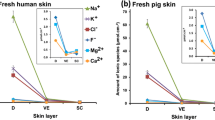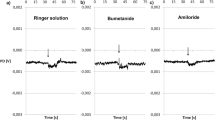Summary
A technique for isolating thestratum corneum from the subjacent layers of the epithelium was developed which permits studying thestratum corneum as an isolated membrane mounted between half-chambers. The method basically consists of an osmotic shock induced by immersing a piece of skin in distilled water at 50°C for 2 min. When the membrane is bathed on each surface by NaCl-Ringer's solution, its electrical resistance is 14.1±1.3 Ω cm2 (n=10). This value is about 1/100 of the whole skin resistance in the presence of the same solution. The hydraulic filtration coefficient (L p ) measured by a hydrostatic pressure method, with identical solutions on each side of the membrane, is 8.8×10−5±1.5×10−5 cm sec−1 atm−1 (n=10) in distilled water and 9.2×10−5±1.4×10−5 cm sec−1 atm−1 (n=10) in NaCl-Ringer's solution. These values are not statistically different and are within the range of 1/80 to 1/120 of the whole skinL p . Thestratum corneum shows an amphoteric character when studied by KCl diffusion potentials at different pH's. The membrane presents an isoelectric pH of 4.6±0.3 (n=10). Above the isoelectric pH the potassium transport number is higher than the chloride transport number; below it, the reverse situation is valid. Divalent cations (Ca++ or Cu++) reduce membrane ionic discrimination when the membrane is negatively charged and are ineffective when the membrane fixed charges are protonated at low pH.
Similar content being viewed by others
References
Amberson, W.R. Klein, H. 1928. The influence of pH upon the concentration potentials across the skin of the frog.J. Gen. Physiol. 11:823
Biber, T.U.L., Sanders, M. 1973. Influence of transepithelial potential difference on the sodium uptake at the outer surface of the isolated frog skin.J. Gen. Physiol. 61:529
Budtz, P.E., Larsen, L.O. 1973. Structure of the toad epidermis during the moulting cycle. I. Light microscopic observations inBufo bufo (L.).Z. Zellforsch. Mikrosk. Ana. 144:353
Eigler, J. 1970. Der Einfluß von Aldosteron auf Natriumtransport und, transepithelialen Wasserfluß durch isolierte Bauchhaut vonRana temporaria.Pfluegers Arch. 317:236
Ewer, R.F. 1951. Water uptake and moulting inBufo regularis Reuss.J. Exp. Biol. 28:369
Glasstone, S. 1946. Textbook of Physical Chemistry D. van Nostrand Company Inc., Toronto
Gunn, R.B., Curran, P.F. 1971. Membrane potentials and ion permeability in a cation exchange membrane.Biophys. J. 11:559
Harned, H.S., Cook, M.A. 1937. The activity and osmotic coefficients of some hydroxidechloride mixtures in aqueous solution.J. Am. Chem. Soc. 59:1890
Harned, H.S., Gancy, A.B. 1958. The activity coefficient of hydrochloric acid in potassium chloride solutions.J. Phys. Chem. 62:627
Jorgensen, C.B. 1949. Permeability of the amphibianskin. II. Effect of moulting of the skin ofAnurans on the permeability to water and electrolytes.Acta Physiol. Scand. 18:171
Katchalsky A., Curran, P.F. 1967. Nonequilibrium Thermodynamics in Biophysics. Harvard University Press, Cambridge, Massachusetts
Lakshminarayanaiah, N. 1969. Transport Phenomena in Membranes. Academic Press, New York
Larsen, E.H. 1969. Active and passive sodium transport and chord resistance in the isolated short-circuited toad skin during aldosterone induced slough formation.Gen. Comp. Endocrinol. 13:516 (Abstr.)
Larsen, E.H. 1970. Sodium transport and D.C. resistance in the isolated toad skin in relation to shedding of thestratum corneum.Acta Physiol. Scand. 79:453
Larsen, E.H. 1971. Effect of aldosterone and oxytocin on the active sodium transport across the isolated toad skin in relation to loosening of thestratum corneum.Gen. Comp. Endocrinol. 17:543
Larsen, E.H. 1971. The relative contributions of sodium and chloride ions to the conductance of toad skin in relation to shedding of thestratum corneum.Acta Physiol. Scand. 81:254
Larsen, E.H. 1972. Characteristics of aldosterone stimulated transport in isolated skin of the toadBufo bufo (L.).J. Steroid Biochem. 3:111
Lindemann, B., Thorns, U. 1967. Fast potential spike of the frog skin generated at the outer surface of the epithelium.Science 158:1473
MacInnes, D.A. 1961. The Principles of Electrochemistry. Dover Publications, Inc. New York
MacRobbie, E.A.C., Ussing, H.H. 1961. Osmotic behaviour of the epithelial cells of frog skin.Acta Physiol. Scand. 53:348
Martinez-Palomo, A., Erlij, D., Bracho, H. 1971. Localization of permeability barriers in the frog skin epithelium.J. Cell Biol. 50:277
Mudd, S. 1925. Electroendosmosis through mammalian serous membranes. I. The hydrogen ion reversal point with buffers containing polyvalent anions.J. Gen. Physiol. 7:389
Nielsen, R. 1969. The effect of aldosteronein vitro on the active sodium transport and moulting of the frog skin.Acta Physiol. Scand. 77:85
Nielsen, R., Tomilson, R.W.S. 1970. The effect of amiloride on sodium transport in the normal and moulting frog skin.Acta Physiol. Scand. 79:238
Nunes, M.A., Lacaz Vieira, F. 1975. Negative potential level in the outer layer of the toad skin.J. Membrane Biol. 24:161
Rawlins, F., Mateu, L., Fragachan, F., Whittembury, G. 1970. Isolated toad skin epithelium: Transport characteristics.Pfluegers Arch. 316:64
Robinson, R.A., Stokes, R.H. 1959. Electrolyte Solutions. Butterworths, London
Scatchard, G. 1953. Ion exchanger electrodes.J. Am. Chem. Soc. 75:2883
Smyth, D.H., Wright, E.M. 1966. Streaming potentials in the rat small intestine.J. Physiol. London 182:591
Staverman, A.J. 1952. Non-equilibrium thermodynamics of membrane processes.Trans. Faraday Soc. 48:176
Ussing, H.H., Zerahn, K. 1951. Active transport of sodium as the source of electric current in, the short-circuited isolated frog skin.Acta Physiol Scand. 23:110
Varanda, W. 1975. Alterações de transporte na pele isolada do sapo associadas à substituições do sódio na solução interna por cátions monovalentes. Master Thesis. University of São Paulo, Brazil
Vôute, C.L., Dirix, R., Nielsen, R., Ussing, H.H. 1969. The effect of aldosterone on the isolated frog skin epithelium (R. temporaria.). A morphological study.Exp. Cell Res. 57:448
Whittembury, G. 1964. Electrical potential profile of the toad skin epithelium.J. Gen. Physiol. 47:795
Wright, E.M., Diamond, J.M. 1968. Effects of pH and polyvalent cations on the selective permeability of gall-bladder epithelium to monovalent ions.Biochim. Biophys. Acta 163:57
Author information
Authors and Affiliations
Rights and permissions
About this article
Cite this article
Vieira, F.L., Nunes, M.A. & Cury, L. Permeability parameters of the toad isolatedstratum corneum . J. Membrain Biol. 27, 251–264 (1976). https://doi.org/10.1007/BF01869139
Received:
Revised:
Issue Date:
DOI: https://doi.org/10.1007/BF01869139




